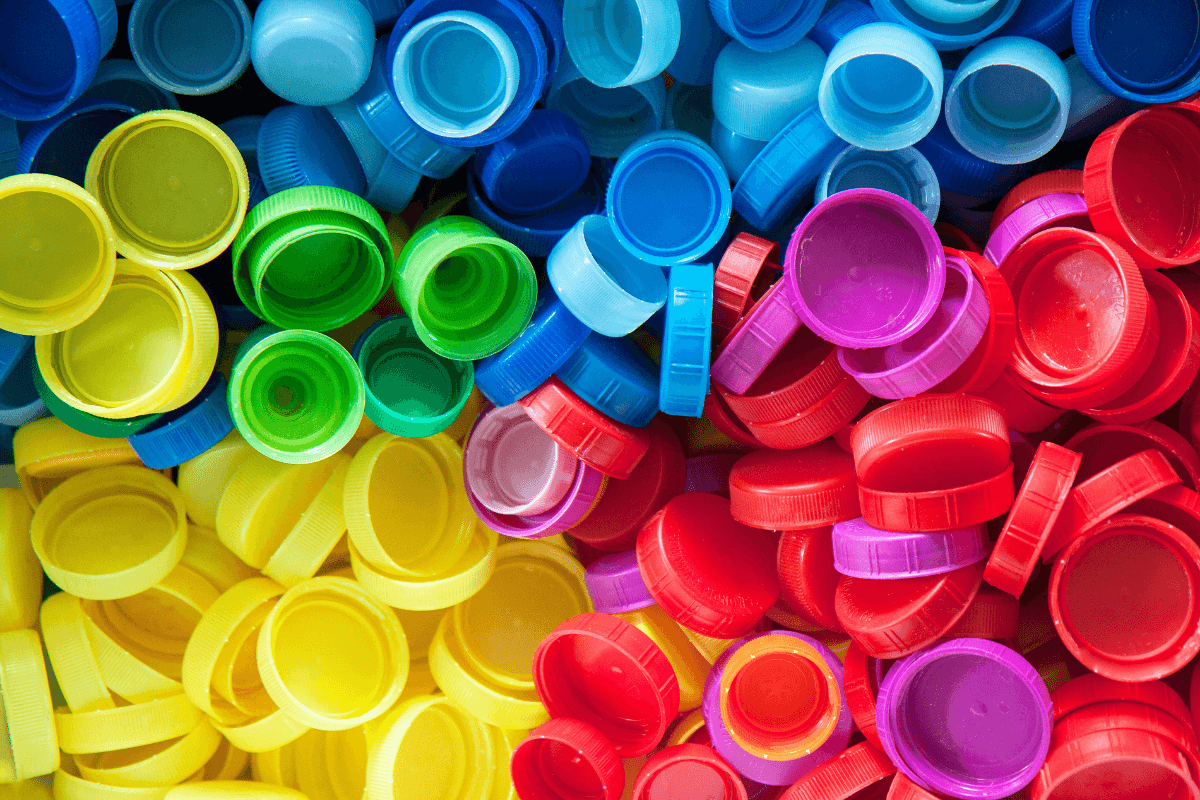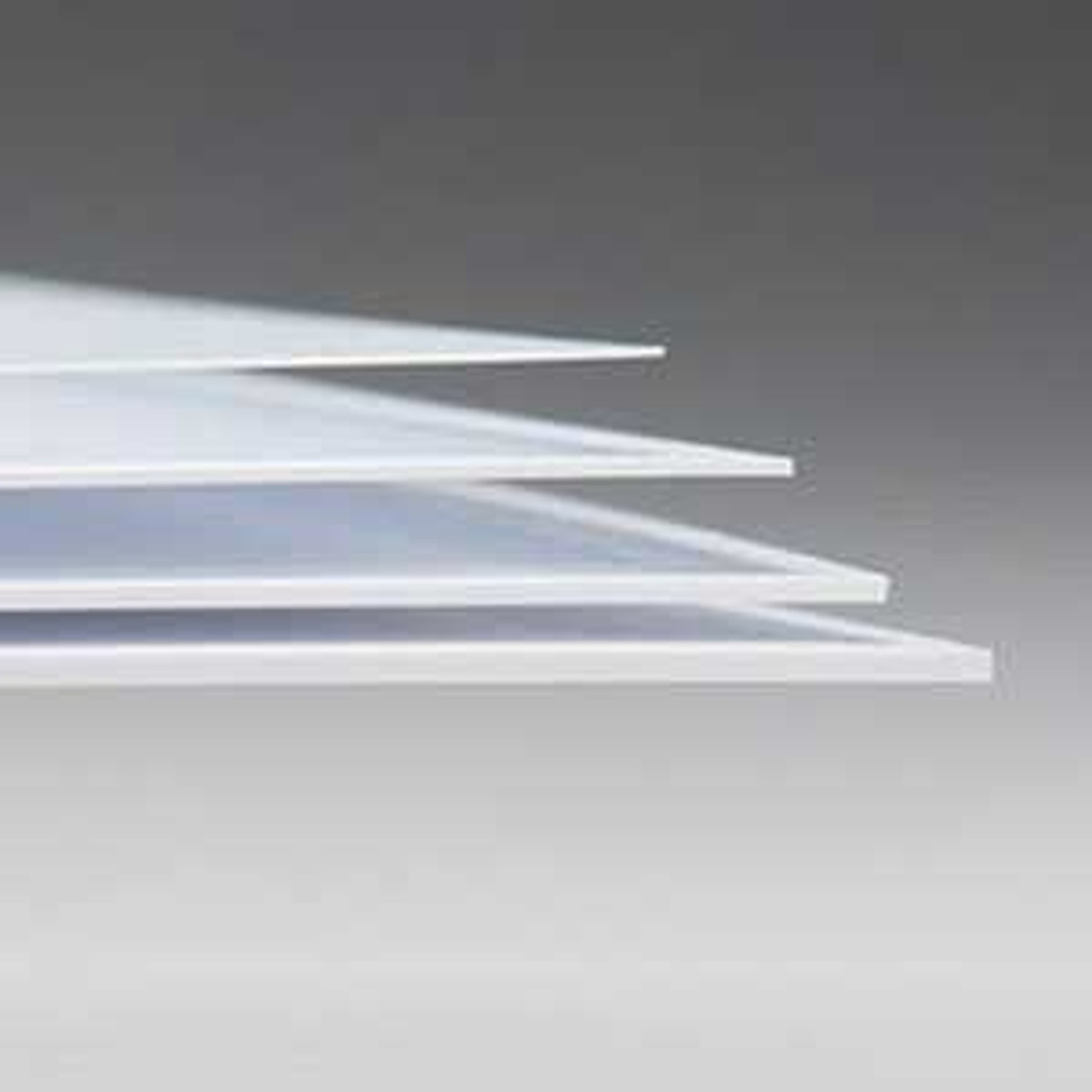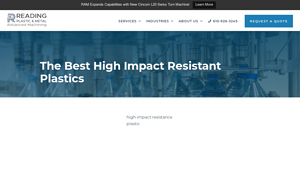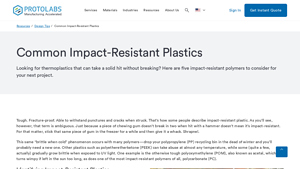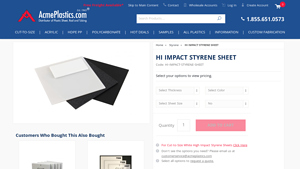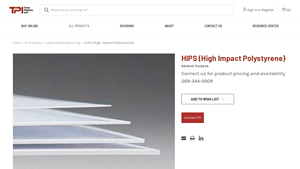High Impact Plastic Guide: Type, Cost, Top List…
Introduction: Navigating the Global Market for high impact plastic
In today’s competitive landscape, sourcing high impact plastic materials that meet the rigorous demands of various industries can be a daunting challenge for international B2B buyers. Whether you’re in the aerospace sector in Germany or the agricultural industry in Brazil, understanding the nuances of high impact plastics is essential for making informed purchasing decisions. This guide offers a comprehensive exploration of high impact plastics, including types like ABS, polycarbonate, and PAI, alongside their applications in sectors ranging from military to food and beverage.
The complexities of supplier vetting, cost considerations, and specific use-case scenarios are critical factors that can significantly influence the success of your projects. By delving into the properties, advantages, and limitations of each material, this guide empowers buyers from Africa, South America, the Middle East, and Europe to navigate the global market effectively. You will gain valuable insights into how to select the right plastic for your needs, ensuring optimal performance and longevity in demanding environments. Armed with this knowledge, you can mitigate risks and enhance the quality of your products, making this guide an indispensable resource for informed decision-making in the high impact plastic domain.
Understanding high impact plastic Types and Variations
| Type Name | Key Distinguishing Features | Primary B2B Applications | Brief Pros & Cons for Buyers |
|---|---|---|---|
| ABS | High impact resistance, easy to machine, low cost | Automotive parts, consumer goods, electronics | Pros: Cost-effective, versatile. Cons: Not suitable for food applications. |
| Polycarbonate | Transparent, excellent toughness, UV resistant | Eyewear, safety equipment, architectural glazing | Pros: High impact resistance, good optical clarity. Cons: Higher cost, prone to scratching. |
| HDPE | Chemical resistant, low moisture absorption | Chemical tanks, playgrounds, marine applications | Pros: Durable, versatile. Cons: Limited heat resistance, stress cracking potential. |
| PAI | High strength, thermal stability, tight tolerances | Aerospace, semiconductor machinery, industrial parts | Pros: Excellent durability, chemical resistance. Cons: Expensive, difficult to process. |
| HIPS | Good impact resistance, lightweight, easy to fabricate | Consumer goods, packaging, electronics | Pros: Cost-effective, reliable under repetitive loads. Cons: Lower temperature resistance. |
What Are the Key Characteristics of ABS Plastic for B2B Buyers?
Acrylonitrile Butadiene Styrene (ABS) is favored for its high impact resistance and machining ease. Its lightweight nature and low cost make it a go-to material across various sectors, including automotive and consumer goods. However, buyers should note that ABS is not suitable for food-related applications, which may limit its utility in certain industries. When considering ABS, assess the specific temperature requirements of your application, as its properties can vary with manufacturing conditions.
How Does Polycarbonate Stand Out Among High Impact Plastics?
Polycarbonate is renowned for its transparency and toughness, making it an ideal glass alternative in many applications, such as eyewear and architectural elements. Its ability to withstand high impacts while offering UV resistance adds to its appeal in safety-critical environments. However, the higher cost and susceptibility to scratches are important considerations for buyers, especially in applications where aesthetics and durability are paramount.
Why Choose HDPE for Industrial Applications?
High-Density Polyethylene (HDPE) is a versatile thermoplastic known for its chemical resistance and tensile strength. It is widely used in applications ranging from chemical storage tanks to outdoor playgrounds. While HDPE offers significant durability, potential issues such as stress cracking under extreme conditions and limited heat resistance should be evaluated during the selection process. Its cost-effectiveness and ease of fabrication make it a practical choice for many industries.
What Makes PAI a Premium Choice in High Impact Plastics?
Polyamide-imide (PAI) is characterized by its exceptional strength and thermal stability, making it suitable for high-performance applications in aerospace and semiconductor machinery. Its ability to maintain tight tolerances under varying temperatures is crucial for precision engineering. However, PAI’s higher cost and processing challenges may deter some buyers. Those seeking robust, long-lasting components that can withstand harsh conditions will find PAI a compelling option.
In What Scenarios Is HIPS Most Beneficial?
High Impact Polystyrene (HIPS) combines good impact resistance with lightweight properties, making it ideal for consumer products and packaging. Its ease of fabrication and cost-effectiveness are significant advantages for manufacturers looking to produce reliable components without breaking the bank. However, HIPS may not perform well under extreme temperatures, which should be taken into account when planning its use in specific applications.
Key Industrial Applications of high impact plastic
| Industry/Sector | Specific Application of high impact plastic | Value/Benefit for the Business | Key Sourcing Considerations for this Application |
|---|---|---|---|
| Automotive | Interior components (e.g., dashboards, trims) | Lightweight, durable parts that improve safety | Ensure compliance with automotive regulations and safety standards. |
| Aerospace | Structural components in aircraft | High strength-to-weight ratio enhances performance | Require materials that meet stringent aerospace specifications and certifications. |
| Medical | Surgical instruments and medical devices | Biocompatibility and durability for safety | Source materials with FDA approval and resistance to sterilization processes. |
| Telecommunications | Enclosures for electronic devices | Protection against impact and environmental factors | Consider thermal and UV resistance for outdoor applications. |
| Construction | Protective barriers and safety equipment | Enhanced safety and durability in harsh conditions | Verify compliance with local building codes and safety regulations. |
How is High Impact Plastic Used in the Automotive Sector?
In the automotive industry, high impact plastics are essential for manufacturing interior components such as dashboards, trims, and panels. These plastics not only provide lightweight solutions that enhance fuel efficiency but also offer improved safety through their impact resistance. For international buyers, particularly in regions like Africa and South America, sourcing materials that comply with local automotive regulations and safety standards is crucial to avoid potential liabilities and ensure product reliability.
What Role Does High Impact Plastic Play in Aerospace Applications?
High impact plastics are increasingly used in aerospace for structural components due to their exceptional strength-to-weight ratio. They help reduce overall aircraft weight, which in turn improves fuel efficiency and performance. For B2B buyers in Europe and the Middle East, it is imperative to source materials that meet rigorous aerospace specifications, including certifications for heat resistance and durability, to maintain compliance and performance in demanding environments.
Why is High Impact Plastic Critical in the Medical Industry?
In the medical sector, high impact plastics are utilized for surgical instruments and medical devices where durability and biocompatibility are paramount. These materials must withstand sterilization processes while maintaining structural integrity and safety. Buyers from regions like Africa and South America should prioritize sourcing FDA-approved materials to ensure compliance with healthcare regulations and enhance patient safety.
How is High Impact Plastic Beneficial in Telecommunications?
Telecommunications companies often use high impact plastics for enclosures that protect electronic devices from environmental damage. These materials offer excellent impact resistance and can withstand thermal and UV exposure, making them suitable for outdoor applications. For international buyers, it is essential to consider the specific environmental conditions of their regions when sourcing these materials to ensure long-lasting performance.
What Advantages Does High Impact Plastic Provide in Construction?
In construction, high impact plastics are employed in protective barriers and safety equipment, providing enhanced durability and safety in harsh conditions. These materials can withstand significant wear and tear, making them ideal for both indoor and outdoor applications. Buyers in Europe and the Middle East should verify that sourced materials comply with local building codes and safety regulations to ensure the structural integrity and safety of construction projects.
3 Common User Pain Points for ‘high impact plastic’ & Their Solutions
Scenario 1: Difficulty in Selecting the Right Type of High Impact Plastic for Specific Applications
The Problem: B2B buyers often struggle with selecting the most suitable type of high impact plastic for their specific applications. For instance, a manufacturer in the automotive sector may need a plastic that not only withstands high impact but also offers thermal stability and chemical resistance. The variety of options like ABS, polycarbonate, and PAI can be overwhelming, especially considering factors such as temperature sensitivity and mechanical properties. This challenge can lead to suboptimal product performance, increased costs, and potential safety issues if the wrong material is selected.
The Solution: To effectively choose the right high impact plastic, buyers should start by conducting a thorough analysis of their application requirements, including environmental conditions, mechanical loads, and regulatory standards. It is advisable to create a checklist that outlines the critical properties needed for the project, such as impact resistance, temperature range, and chemical exposure. Consulting with material suppliers who can provide technical data sheets and application-specific insights will also be beneficial. Additionally, prototypes made from different plastics can help assess performance in real-world conditions before committing to a large-scale production run.
Scenario 2: Concerns Over Long-Term Durability and Cost Efficiency of High Impact Plastics
The Problem: Many B2B buyers are apprehensive about the long-term durability and cost-effectiveness of high impact plastics, particularly in harsh environments. For example, a company in the oil and gas industry might worry that the plastics used in equipment housings will degrade due to exposure to chemicals or extreme temperatures, leading to frequent replacements and increased operational costs. This uncertainty can hinder decision-making and lead to reluctance in fully integrating high impact plastics into their manufacturing processes.
The Solution: To address concerns about durability, B2B buyers should prioritize sourcing high-quality materials from reputable manufacturers known for rigorous testing and quality assurance practices. Conducting a life-cycle assessment (LCA) can provide insights into the long-term performance and cost implications of using specific high impact plastics. Collaborating with suppliers to develop a tailored solution that includes performance guarantees or warranties can also help mitigate risks. Furthermore, considering alternative processing methods, such as injection molding, can enhance the structural integrity of the final product, thereby improving durability and reducing long-term costs.
Scenario 3: Challenges in Maintaining Consistency in Manufacturing Processes
The Problem: B2B manufacturers often face challenges in maintaining consistency in their production processes when using high impact plastics. Variability in material properties, such as moisture content or temperature during processing, can lead to inconsistencies in product quality. This is particularly critical in industries like aerospace and medical devices, where precision is paramount. Inconsistent products can result in increased waste, rework, and compliance issues, ultimately affecting customer satisfaction and profitability.
The Solution: To ensure consistency in manufacturing processes, buyers should implement strict material handling and storage protocols to minimize variability in plastic properties. Utilizing advanced monitoring technologies, such as real-time sensors for temperature and humidity control during processing, can significantly enhance production reliability. Additionally, establishing clear communication channels with suppliers about material batches and specifications can help in tracking any variations. Regular training sessions for manufacturing staff on best practices for processing high impact plastics will also contribute to maintaining quality standards and minimizing defects.
Strategic Material Selection Guide for high impact plastic
What Are the Key Properties of Common High Impact Plastics?
When selecting high impact plastics for various applications, understanding the key properties of each material is crucial. These properties directly influence product performance, durability, and suitability for specific environments. Below, we analyze four common high impact plastics: ABS, Polycarbonate, HDPE, and PAI, focusing on their properties, advantages, disadvantages, and considerations for international buyers.
How Does ABS Perform in High Impact Applications?
Acrylonitrile Butadiene Styrene (ABS) is known for its excellent impact resistance, making it ideal for applications such as automotive parts and consumer goods. Key properties include a temperature rating of approximately -20°C to 80°C and good chemical resistance.
Pros: ABS is cost-effective, easy to machine, and bonds well with adhesives. Its versatility allows for a wide range of applications, from toys to industrial components.
Cons: Despite its toughness, ABS is not suitable for food contact applications and can become more brittle at low temperatures.
Impact on Application: ABS is compatible with various media, but its limitations in temperature and chemical exposure must be considered.
International Considerations: Buyers in regions like Europe and South America should ensure compliance with standards such as ASTM D256 for impact testing and consider local regulations regarding material safety.
What Advantages Does Polycarbonate Offer?
Polycarbonate (PC) is another high-impact plastic known for its exceptional toughness and transparency, often used as a glass alternative in safety equipment and architectural applications. It can withstand temperatures ranging from -40°C to 120°C.
Pros: The material’s high impact resistance and excellent optical clarity make it suitable for protective gear and transparent barriers.
Cons: Polycarbonate can be expensive and is prone to scratching, which may limit its use in certain applications.
Impact on Application: PC is ideal for environments requiring high visibility and impact resistance, but its susceptibility to UV degradation over time is a concern.
International Considerations: Compliance with standards such as DIN 4102 for fire behavior is essential for buyers in Europe, while those in Africa and South America should be aware of local safety regulations.
Why Choose HDPE for High Impact Applications?
High-Density Polyethylene (HDPE) is a versatile thermoplastic known for its high impact resistance and tensile strength. It performs well in temperatures ranging from -50°C to 80°C.
Pros: HDPE is lightweight, cost-effective, and resistant to chemicals, making it suitable for applications like chemical tanks and playground equipment.
Cons: While durable, HDPE can suffer from stress cracking under extreme conditions and has limited heat resistance.
Impact on Application: Its chemical resistance makes HDPE suitable for various media, but it may not perform well in high-temperature applications.
International Considerations: Buyers should ensure compliance with ASTM D638 for tensile properties and consider local environmental regulations, particularly in regions like the Middle East where heat and UV exposure are significant factors.
What Makes PAI a Strong Choice for Specialized Applications?
Polyamide-imide (PAI) is a high-performance plastic that excels in extreme conditions, maintaining stability in temperatures up to 260°C. Its key properties include high tensile strength and excellent chemical resistance.
Pros: PAI’s ability to hold tight tolerances and resist wear makes it suitable for aerospace and semiconductor applications.
Cons: The material is expensive and challenging to process, which may limit its use to specialized applications.
Impact on Application: PAI is ideal for high-stress environments but may not be suitable for wet conditions due to its limited hydrolysis resistance.
International Considerations: Compliance with stringent aerospace and semiconductor industry standards is critical for international buyers, particularly in Europe and North America.
Summary of Material Selection for High Impact Plastics
| Material | Typical Use Case for High Impact Plastic | Key Advantage | Key Disadvantage/Limitation | Relative Cost (Low/Med/High) |
|---|---|---|---|---|
| ABS | Automotive parts, consumer goods | Cost-effective and versatile | Not suitable for food applications | Medium |
| Polycarbonate | Safety equipment, architectural glazing | High impact resistance and clarity | Expensive and scratch-prone | High |
| HDPE | Chemical tanks, playground equipment | Lightweight and chemically resistant | Susceptible to stress cracking | Low |
| PAI | Aerospace components, semiconductor machinery | Excellent thermal stability and wear resistance | Expensive and difficult to process | High |
This guide serves as a strategic resource for international B2B buyers looking to make informed decisions regarding high impact plastics, ensuring compliance with relevant standards and optimizing material selection for their specific applications.
In-depth Look: Manufacturing Processes and Quality Assurance for high impact plastic
What Are the Key Manufacturing Processes for High Impact Plastics?
The manufacturing of high impact plastics involves several critical stages that ensure the material’s properties meet specific industry requirements. The main stages include material preparation, forming, assembly, and finishing. Each stage employs unique techniques tailored to the type of plastic being produced and the end application’s demands.
How Is Material Prepared for High Impact Plastic Manufacturing?
Material preparation is the initial stage where raw plastic materials, such as ABS, polycarbonate, HDPE, or PAI, are sourced and processed. This stage typically involves the following steps:
-
Material Selection: Choosing the appropriate type of high impact plastic based on application requirements, such as strength, temperature resistance, and chemical exposure.
-
Compounding: Raw plastic pellets are often blended with additives like colorants, stabilizers, and impact modifiers to enhance specific properties. This process may involve extrusion, where the mixture is melted and forced through a die to create a uniform feedstock.
-
Drying: Many plastics, particularly those sensitive to moisture like polycarbonate, require drying to eliminate any absorbed water, which can affect the quality of the final product.
What Forming Techniques Are Used in High Impact Plastic Production?
Once the materials are prepared, the next stage is forming. This involves shaping the plastic into the desired form using various techniques:
-
Injection Molding: A prevalent method for high-volume production, where molten plastic is injected into a mold. This technique is ideal for creating complex shapes and ensures tight tolerances.
-
Blow Molding: Commonly used for hollow parts, this method involves inflating a heated plastic tube (parison) inside a mold. It’s widely used for producing containers and bottles from HDPE.
-
Thermoforming: In this process, sheets of plastic are heated until pliable and then formed over a mold. It is suitable for producing larger, thinner parts and is often used in packaging and consumer goods.
-
Machining: For applications requiring precision, CNC machining is employed. This method involves cutting and shaping the plastic using computer-controlled tools to achieve high tolerances.
How Is Assembly and Finishing Conducted for High Impact Plastics?
After forming, assembly and finishing processes enhance the functionality and aesthetics of the high impact plastic products:
-
Assembly: Components may require assembly through methods such as welding, adhesive bonding, or mechanical fastening. This stage is critical for multi-part products that must meet strict performance standards.
-
Finishing: Techniques such as surface treatment, painting, or coating can be applied to improve durability, resistance to UV light, or aesthetic appeal. Finishing processes may also include polishing or texturing to meet specific design requirements.
What Are the Quality Assurance Standards for High Impact Plastics?
Quality assurance is vital in the manufacturing of high impact plastics to ensure products meet international and industry-specific standards. Adhering to these standards helps mitigate risks associated with product failure and enhances customer satisfaction.
Which International Standards Are Relevant for High Impact Plastic Manufacturers?
One of the most recognized quality management standards is ISO 9001, which outlines requirements for a quality management system (QMS). Companies seeking ISO 9001 certification demonstrate their commitment to maintaining consistent quality and customer satisfaction.
In addition to ISO 9001, other standards may apply depending on the industry:
- CE Marking: Indicates conformity with health, safety, and environmental protection standards for products sold within the European Economic Area.
- API Standards: Relevant for plastics used in the oil and gas sector, ensuring materials meet rigorous safety and performance criteria.
What Are the Key Quality Control Checkpoints in High Impact Plastic Manufacturing?
Quality control (QC) is integrated at various stages of the manufacturing process to ensure that the final product meets established standards. Key QC checkpoints include:
-
Incoming Quality Control (IQC): Raw materials are inspected upon arrival to ensure they meet specified quality standards. This may involve checking material specifications, moisture content, and physical properties.
-
In-Process Quality Control (IPQC): During production, ongoing inspections are conducted to monitor processes and detect any deviations from quality standards. This may include regular checks of temperature, pressure, and cycle times in molding processes.
-
Final Quality Control (FQC): The final product undergoes rigorous testing and inspection before shipment. Common methods include visual inspections, dimensional checks, and performance tests, such as impact resistance assessments using the Notched IZOD test.
How Can B2B Buyers Verify Supplier Quality Control?
For international B2B buyers, particularly those from regions like Africa, South America, the Middle East, and Europe, verifying a supplier’s quality control practices is crucial. Here are some actionable strategies:
-
Supplier Audits: Conducting on-site audits can provide firsthand insight into a supplier’s manufacturing processes and quality management systems. This can help identify potential risks and assess compliance with international standards.
-
Quality Reports: Request detailed quality reports that outline the results of IQC, IPQC, and FQC processes. These reports should include metrics, testing methods, and any corrective actions taken.
-
Third-Party Inspections: Engaging independent third-party inspection agencies can validate the quality and compliance of products. This adds an extra layer of assurance, particularly for high-stakes industries such as aerospace or medical.
-
Certifications and Compliance: Verify that suppliers hold relevant certifications (e.g., ISO, CE) and have documented compliance with industry-specific standards. This information can often be found on the supplier’s website or through direct inquiry.
What Are the Quality Control Nuances for International Buyers?
When engaging with suppliers across different regions, international buyers must be aware of various nuances that can affect quality control:
- Cultural Differences: Understanding local manufacturing practices and cultural attitudes towards quality can inform your approach to supplier relations.
- Regulatory Variations: Different countries may have unique regulatory requirements affecting material specifications and testing standards. Familiarizing yourself with these can prevent compliance issues.
- Communication Challenges: Language barriers may impact the clarity of quality requirements. Establishing clear communication channels and documentation is essential to mitigate misunderstandings.
By thoroughly understanding the manufacturing processes and quality assurance practices for high impact plastics, B2B buyers can make informed decisions and build strong partnerships with suppliers, ensuring the reliability and performance of their products.
Practical Sourcing Guide: A Step-by-Step Checklist for ‘high impact plastic’
Introduction
Sourcing high impact plastic materials requires a strategic approach to ensure that you choose the right products for your specific needs. This guide provides a practical checklist to help B2B buyers navigate the procurement process, ensuring they select the best materials and suppliers to meet their requirements in various applications, from industrial manufacturing to consumer goods.
Step 1: Define Your Technical Specifications
Establishing clear technical specifications is critical to your sourcing process. Consider the mechanical properties required for your application, such as impact resistance, tensile strength, and thermal stability. Additionally, assess the environmental conditions the materials will face, including temperature extremes and exposure to chemicals.
- Key Attributes to Specify:
- Impact resistance ratings (e.g., Notched IZOD values).
- Temperature resistance and performance under stress.
Step 2: Research Available Material Options
Familiarize yourself with the different types of high impact plastics available in the market. Common materials like ABS, polycarbonate, HDPE, and PAI each have unique properties that make them suitable for various applications. Understanding these materials will help you match them to your project needs effectively.
- Considerations for Each Material:
- ABS: Good for general applications but not food-safe.
- Polycarbonate: Excellent for transparency and impact resistance but can be expensive.
Step 3: Evaluate Supplier Certifications
Before engaging with a supplier, verify their certifications and compliance with industry standards. Look for ISO certifications, material safety data sheets (MSDS), and any relevant quality assurance processes that indicate a commitment to high standards.
- Essential Certifications:
- ISO 9001 for quality management.
- Compliance with local and international safety regulations.
Step 4: Request Samples for Testing
Once you have shortlisted potential suppliers, request samples of the high impact plastics you are considering. Testing samples in your specific application environment can provide valuable insights into their performance and suitability.
- Testing Considerations:
- Evaluate the material’s durability, flexibility, and overall performance under expected conditions.
- Conduct stress tests to simulate real-world applications.
Step 5: Assess Pricing and Total Cost of Ownership
While price is an important factor, consider the total cost of ownership, which includes manufacturing, shipping, and potential waste. Compare quotes from multiple suppliers, but also weigh the long-term benefits of using higher-quality materials that may reduce maintenance and replacement costs.
- Cost Breakdown:
- Evaluate initial purchase price versus durability and lifespan.
- Consider logistical costs, especially if sourcing internationally.
Step 6: Check Supplier Reputation and Reviews
Investigate the reputation of potential suppliers through customer reviews and industry references. Reach out to other businesses in your network that have experience with the suppliers you are considering.
- Research Sources:
- Online review platforms and industry forums.
- Direct inquiries to past clients for feedback on product quality and service.
Step 7: Finalize Contractual Agreements
Once you have selected a supplier, ensure that all terms are clearly outlined in a contract. This should include pricing, delivery timelines, quality assurance commitments, and return policies. A well-drafted agreement will protect your interests and provide a clear framework for your business relationship.
- Contract Essentials:
- Include clauses for product quality and performance guarantees.
- Specify penalties for late deliveries or non-compliance with specifications.
By following this checklist, B2B buyers can make informed decisions when sourcing high impact plastics, ensuring they select materials and suppliers that align with their operational requirements and business goals.
Comprehensive Cost and Pricing Analysis for high impact plastic Sourcing
What Are the Key Cost Components in High Impact Plastic Sourcing?
When sourcing high impact plastics, understanding the cost structure is crucial for B2B buyers. The primary components that contribute to the overall cost include:
-
Materials: The type of plastic selected—such as ABS, polycarbonate, HDPE, PAI, or HIPS—will significantly influence the material cost. For instance, while ABS and HDPE are typically more affordable, advanced materials like PAI may incur higher costs due to their specialized properties.
-
Labor: Labor costs vary by region and complexity of the manufacturing process. Skilled labor is often necessary for machining and custom fabrication, which can increase overall expenses.
-
Manufacturing Overhead: This includes utilities, facility maintenance, and equipment depreciation. Overhead costs can fluctuate depending on the supplier’s location and operational efficiency.
-
Tooling: Custom tooling for specific parts can be a substantial upfront investment. Buyers should consider the amortization of these costs over the expected production volume.
-
Quality Control (QC): Implementing stringent QC measures ensures that the products meet required specifications and certifications, particularly for industries like aerospace or medical. This can add to the overall cost.
-
Logistics: Shipping costs, which may include import duties and tariffs, are also a significant factor, especially for international buyers. The distance from the supplier to the buyer’s location can greatly affect these expenses.
-
Margin: Suppliers typically add a profit margin that can vary widely based on market demand, competition, and the perceived value of their offerings.
How Do Price Influencers Affect High Impact Plastic Costs?
Several factors can influence the pricing of high impact plastics, including:
-
Volume and Minimum Order Quantity (MOQ): Larger orders often lead to lower per-unit costs due to economies of scale. Buyers should negotiate MOQs to optimize pricing.
-
Specifications and Customization: Custom designs or unique specifications can increase costs due to the need for specialized tooling or materials. Buyers should clearly define their requirements to avoid unexpected expenses.
-
Material Selection: The choice of material significantly impacts cost; for example, polycarbonate, while highly impact-resistant, is more expensive than ABS.
-
Quality and Certifications: Products that require specific certifications (e.g., FDA approval for food-related applications) may incur higher costs due to additional testing and compliance processes.
-
Supplier Factors: The supplier’s reputation, location, and reliability can affect pricing. Established suppliers may charge a premium for quality assurance and timely delivery.
-
Incoterms: The agreed-upon Incoterms dictate the responsibilities of buyers and sellers regarding shipping, insurance, and customs clearance. Understanding these terms can help avoid additional costs.
What Are Effective Buyer Tips for Cost-Efficiency in High Impact Plastic Sourcing?
To achieve cost-efficiency in sourcing high impact plastics, buyers should consider the following strategies:
-
Negotiate Contracts: Engage in open discussions with suppliers regarding pricing, MOQ, and payment terms. Building a strong relationship can lead to better pricing and terms.
-
Assess Total Cost of Ownership (TCO): Beyond initial purchase price, consider long-term costs such as maintenance, durability, and performance. Materials with higher initial costs may offer better longevity and lower TCO.
-
Understand Pricing Nuances for International Buyers: International buyers must account for currency fluctuations, shipping delays, and local regulations that can affect overall costs. It’s advisable to work with suppliers familiar with the local market dynamics.
-
Request Samples: Before committing to large orders, request samples to evaluate quality and performance. This can prevent costly mistakes later in the production process.
-
Leverage Technology: Utilize software solutions for inventory management and procurement to optimize orders and reduce excess inventory costs.
In conclusion, comprehending the intricate cost components and pricing influencers associated with high impact plastic sourcing is vital for B2B buyers. By employing strategic negotiation and thorough market analysis, businesses can effectively manage their sourcing costs and enhance their competitive edge.
Alternatives Analysis: Comparing high impact plastic With Other Solutions
Exploring Alternatives to High Impact Plastic: A Comparative Analysis
In the quest for durable and reliable materials, high impact plastics are often favored for their impressive strength and versatility. However, various alternatives also exist that may better serve specific applications or budget constraints. Understanding these options allows B2B buyers to make informed decisions that align with their operational needs and project requirements.
Comparison Table
| Comparison Aspect | High Impact Plastic | Metal Alloys | Composites |
|---|---|---|---|
| Performance | Excellent impact resistance, lightweight, and corrosion-resistant | High strength-to-weight ratio, excellent durability, and rigidity | Good tensile strength, lightweight, and tailored properties |
| Cost | Generally lower cost | Higher initial cost, variable based on alloy type | Moderate to high cost depending on materials used |
| Ease of Implementation | Easy to machine and fabricate | More complex machining processes | Requires specialized fabrication techniques |
| Maintenance | Low maintenance; resistant to chemicals | Requires regular maintenance to prevent corrosion | May require periodic inspection and maintenance |
| Best Use Case | Electronics, automotive parts, construction | Structural components, automotive frames, aerospace | Sporting goods, automotive components, and specialized applications |
Detailed Breakdown of Alternatives
Metal Alloys
Metal alloys, such as aluminum and steel, provide exceptional strength and rigidity, making them suitable for high-stress applications. They are often used in industries like aerospace and automotive due to their high strength-to-weight ratio. However, the initial cost of metal alloys can be significantly higher than high impact plastics. Additionally, machining metal requires more complex processes and tools, increasing production time. While metals are durable, they may require ongoing maintenance to prevent corrosion, especially in harsh environments.
Composites
Composites, which combine two or more materials to enhance specific properties, offer a unique alternative to high impact plastics. They can be engineered to provide excellent tensile strength while remaining lightweight. This makes them popular in industries such as automotive and aerospace, where performance and weight savings are critical. However, the cost of composites can vary widely based on the materials used, often making them more expensive than high impact plastics. Additionally, their fabrication may require specialized techniques, which can complicate the manufacturing process. Despite these challenges, composites can deliver tailored performance, making them ideal for specialized applications.
Conclusion: How to Choose the Right Solution for Your Needs
When selecting the right material for your project, consider factors such as performance requirements, budget constraints, and ease of implementation. High impact plastics may be the best choice for applications requiring lightweight, cost-effective solutions with low maintenance. Conversely, metal alloys may be preferable for high-stress environments where strength is paramount, while composites can provide tailored properties for specialized needs. By assessing the specific demands of your application and weighing the pros and cons of each option, you can ensure that your choice aligns with both operational goals and financial considerations.
Essential Technical Properties and Trade Terminology for high impact plastic
What Are the Key Technical Properties of High Impact Plastics?
When selecting high impact plastics, several critical specifications must be considered to ensure optimal performance in demanding applications. Understanding these properties can significantly influence product longevity and performance, particularly in sectors like automotive, medical, and aerospace.
1. Material Grade
Material grade refers to the specific formulation of a plastic that defines its physical and chemical properties. For high impact plastics, grades are often categorized by their toughness, heat resistance, and impact strength. Selecting the appropriate material grade is essential for meeting regulatory standards and ensuring the product can withstand the intended operational environment.
2. Tolerance
Tolerance indicates the permissible limit of variation in a physical dimension of a part. In high impact applications, maintaining tight tolerances is critical to ensure components fit together correctly, thereby preventing premature failure. This is especially important in sectors such as aerospace, where safety and precision are paramount.
3. Notched IZOD Impact Strength
This metric measures a material’s resistance to impact forces by assessing the energy absorbed before breaking. A higher Notched IZOD value indicates greater impact resistance. For B2B buyers, understanding this property helps in selecting materials that can endure the specific impact loads expected in their applications, thus reducing the risk of part failure.
4. Chemical Resistance
Chemical resistance describes a material’s ability to withstand exposure to various chemicals without degrading. High impact plastics often encounter harsh environments, making this property crucial for applications in industries like oil and gas, where exposure to corrosive substances is common. Assessing chemical resistance can prevent costly failures and extend the service life of components.
5. Thermal Stability
Thermal stability refers to a material’s ability to maintain its properties under varying temperature conditions. High impact plastics with excellent thermal stability can perform reliably in extreme temperatures, making them ideal for applications in automotive and aerospace sectors where components are exposed to fluctuating thermal environments.
6. Moisture Absorption
Moisture absorption is the degree to which a plastic can take in water. This property affects the material’s strength and dimensional stability. For applications in humid or wet environments, low moisture absorption is critical to ensure the integrity and longevity of the plastic components.
What Are Common Trade Terms Related to High Impact Plastics?
Understanding industry jargon is essential for navigating the procurement process effectively. Here are some common terms that B2B buyers should be familiar with:
1. OEM (Original Equipment Manufacturer)
An OEM refers to a company that produces parts or equipment that may be marketed by another manufacturer. In the context of high impact plastics, OEMs often require custom solutions tailored to their specifications, making it vital for suppliers to understand these needs and provide appropriate options.
2. MOQ (Minimum Order Quantity)
MOQ is the smallest quantity of a product that a supplier is willing to sell. For high impact plastics, knowing the MOQ is essential for budget planning and inventory management. Buyers must align their order quantities with their production schedules to avoid excess inventory or stockouts.
3. RFQ (Request for Quotation)
An RFQ is a standard business process where a buyer requests pricing and other details from suppliers. This is particularly important in the high impact plastic industry, where material costs can vary significantly based on specifications and order volume. A well-structured RFQ can lead to more favorable terms and pricing.
4. Incoterms
Incoterms are international commercial terms that define the responsibilities of buyers and sellers in shipping arrangements. They clarify who is responsible for shipping costs, insurance, and risk during transport. Understanding Incoterms is crucial for B2B buyers to ensure smooth logistics and avoid unexpected expenses.
5. Lead Time
Lead time refers to the period from the initiation of an order to its completion and delivery. In high impact plastic manufacturing, lead times can vary based on material availability and production schedules. Buyers should account for lead times in their project planning to ensure timely delivery of components.
By familiarizing themselves with these technical properties and trade terms, B2B buyers can make informed decisions that align with their operational requirements and business goals.
Navigating Market Dynamics and Sourcing Trends in the high impact plastic Sector
What Are the Current Market Dynamics for High Impact Plastics?
The high impact plastic market is experiencing robust growth, driven by increasing demand across various industries such as automotive, aerospace, medical, and consumer goods. Factors such as urbanization, technological advancements, and the need for lightweight, durable materials are propelling this growth. Notably, regions like Africa and South America are witnessing a surge in construction and infrastructure projects, which significantly boosts the demand for high impact plastics that can withstand harsh conditions. In Europe, particularly Germany, the automotive sector’s shift towards sustainable and lightweight materials is also influencing sourcing trends.
Emerging technologies such as additive manufacturing and CNC machining are reshaping the landscape, enabling customized solutions and reducing lead times. As international B2B buyers look to optimize supply chains, many are adopting digital procurement platforms that facilitate real-time sourcing and inventory management. Blockchain technology is also gaining traction, enhancing transparency and traceability in the supply chain, which is crucial for quality assurance and regulatory compliance.
How Is Sustainability Shaping the High Impact Plastic Sector?
Sustainability is becoming a critical consideration for B2B buyers in the high impact plastic sector. The environmental impact of plastic production and disposal has prompted companies to seek ethically sourced materials that minimize ecological footprints. This shift not only aligns with global sustainability goals but also caters to the growing consumer demand for environmentally responsible products.
To meet these expectations, suppliers are increasingly offering ‘green’ certifications for their materials, indicating compliance with environmental standards. Bioplastics and recycled plastics are gaining prominence, providing alternatives that reduce reliance on fossil fuels while maintaining high performance. Buyers are encouraged to prioritize suppliers who demonstrate a commitment to ethical sourcing and sustainability, as this can enhance brand reputation and market competitiveness.
How Has the High Impact Plastic Industry Evolved Over Time?
The evolution of high impact plastics can be traced back to the mid-20th century when materials such as ABS and polycarbonate were first developed. Initially utilized in consumer goods and automotive applications, these materials gained recognition for their outstanding impact resistance and versatility. Over the decades, advancements in polymer science have led to the creation of specialized plastics, such as polyamide-imide (PAI), which cater to high-performance applications in aerospace and semiconductor industries.
As industries evolve, so too does the demand for innovative, sustainable solutions. The contemporary focus on reducing environmental impacts and enhancing material performance underscores the dynamic nature of the high impact plastic market, paving the way for future developments that will continue to meet the needs of diverse sectors.
Frequently Asked Questions (FAQs) for B2B Buyers of high impact plastic
-
How do I select the right high impact plastic for my application?
Choosing the appropriate high impact plastic involves evaluating specific material properties such as impact resistance, temperature tolerance, and chemical compatibility. Consider the operational environment and mechanical stresses the material will face. For example, ABS is excellent for general-purpose applications, while PAI is ideal for high-temperature settings requiring tight tolerances. Consult with suppliers to discuss your application needs and obtain samples for testing before making a final decision. -
What are the most common types of high impact plastics used in manufacturing?
The most widely used high impact plastics include ABS, polycarbonate, HDPE, and PAI. ABS is favored for its versatility and ease of machining, while polycarbonate is often used for applications requiring transparency and high impact resistance. HDPE is known for its durability and chemical resistance, making it suitable for outdoor and marine applications. PAI excels in high-stress environments, particularly in aerospace and semiconductor industries. -
What are the minimum order quantities (MOQs) for high impact plastics?
Minimum order quantities for high impact plastics can vary significantly between suppliers and depend on the type of plastic, the complexity of the parts, and the manufacturing processes involved. Typically, MOQs can range from a few kilograms to several tons. It’s essential to discuss your specific requirements with suppliers to understand their MOQs, as some may offer flexibility for smaller orders or prototypes. -
What customization options are available for high impact plastic products?
Customization options for high impact plastic products can include varying thicknesses, colors, surface finishes, and machining specifications. Many suppliers also offer custom fabrication services to create parts tailored to specific dimensions and tolerances. Engaging directly with manufacturers can help identify the best customization options for your project, ensuring the final product meets your precise requirements. -
How can I ensure quality assurance when sourcing high impact plastics internationally?
To ensure quality assurance when sourcing high impact plastics, conduct thorough supplier vetting. Request samples and certifications that demonstrate compliance with international quality standards, such as ISO 9001. Establish clear specifications and quality control measures in your contracts. Regular communication and possibly on-site inspections can further enhance confidence in the product quality and supplier reliability. -
What payment terms should I expect when purchasing high impact plastics?
Payment terms for high impact plastics can vary widely depending on the supplier and the nature of the transaction. Common terms include advance payment, letter of credit, or net 30/60 days after delivery. It’s crucial to clarify payment conditions during negotiations and ensure they align with your financial processes. Understanding the supplier’s payment preferences can help facilitate smoother transactions. -
What logistics considerations should I keep in mind when importing high impact plastics?
Logistics considerations when importing high impact plastics include shipping methods, lead times, customs regulations, and potential tariffs. Determine the best shipping option based on cost and urgency, and ensure compliance with local import regulations. Collaborating with a freight forwarder familiar with your destination country can streamline the process, reducing delays and unexpected costs. -
How can I assess the environmental impact of high impact plastics?
Assessing the environmental impact of high impact plastics involves evaluating factors such as recyclability, lifecycle assessments, and compliance with environmental regulations. Many suppliers now provide information on the sustainability of their materials, including whether they are sourced from recycled content. Consider choosing suppliers that prioritize eco-friendly practices and offer certifications, such as ISO 14001, to ensure that their production methods align with your sustainability goals.
Important Disclaimer & Terms of Use
⚠️ Important Disclaimer
The information provided in this guide, including content regarding manufacturers, technical specifications, and market analysis, is for informational and educational purposes only. It does not constitute professional procurement advice, financial advice, or legal advice.
While we have made every effort to ensure the accuracy and timeliness of the information, we are not responsible for any errors, omissions, or outdated information. Market conditions, company details, and technical standards are subject to change.
B2B buyers must conduct their own independent and thorough due diligence before making any purchasing decisions. This includes contacting suppliers directly, verifying certifications, requesting samples, and seeking professional consultation. The risk of relying on any information in this guide is borne solely by the reader.
Top 7 High Impact Plastic Manufacturers & Suppliers List
1. Reading Plastic – Top 4 High Impact Resistant Plastics
Domain: readingplastic.com
Registered: 1998 (27 years)
Introduction: Top 4 High Impact Resistant Plastics: 1. ABS (Acrylonitrile Butadiene Styrene): – Widely used thermoplastic – Applications: toy building blocks, automotive parts, instrument panels – Properties: outstanding impact resistance, lightweight, easy to machine, low cost, good strength and stiffness, easy to paint and bond, resistant to chemical corrosion. 2. Polycarbonate: – Known for transparency, can …
2. PolymerShapes – High Impact Polystyrene (HIPS)
Domain: polymershapes.com
Registered: 2000 (25 years)
Introduction: {“Product Name”: “High Impact Polystyrene (HIPS)”, “Also Known As”: “PS (Polystyrene)”, “Material Type”: “Amorphous thermoplastic”, “Applications”: “Lower heat applications”, “Category”: “Standard material”, “Benefits”: [“High impact strength”, “Can be printed using Digital, Screen, Flexo, and Litho inks”, “Fabricates well (guillotine cut, die-cut, punched, formed)”, “Easy to Thermoform”, “Good di…
3. McMaster – Impact-Resistant Plastics
Domain: mcmaster.com
Registered: 1994 (31 years)
Introduction: This company, McMaster – Impact-Resistant Plastics, is a notable entity in the market. For specific product details, it is recommended to visit their website directly.
4. Protolabs – Impact-Resistant Plastics
Domain: protolabs.com
Registered: 2006 (19 years)
Introduction: Common impact-resistant plastics include polyetheretherketone (PEEK), polyoxymethylene (POM, also known as acetal), and polycarbonate (PC). These materials are characterized by their ability to withstand impacts without breaking, although their performance can vary based on temperature and exposure to UV light. Key testing methods for evaluating impact resistance include Notched Izod Impact, Gardn…
5. Acme Plastics – High Impact Styrene Sheets
Domain: acmeplastics.com
Registered: 1997 (28 years)
Introduction: This company, Acme Plastics – High Impact Styrene Sheets, is a notable entity in the market. For specific product details, it is recommended to visit their website directly.
6. The Free Dictionary – High-Impact Plastic
Domain: thefreedictionary.com
Registered: 2003 (22 years)
Introduction: High-impact plastic is a synthetic thermoplastic material obtained by polymerizing styrene. It is characterized by its rigidity and transparency, making it suitable for various applications including insulation and packing. High-impact plastic can be molded into objects or made into a foam, commonly known as expanded polystyrene, which is used for thermal insulation. It is also noted for its energ…
7. Total Plastics – HIPS (High Impact Polystyrene)
Domain: totalplastics.com
Registered: 1996 (29 years)
Introduction: {“Product Name”: “HIPS (High Impact Polystyrene)”, “SKU”: “Contact us for product pricing and availability”, “Material”: “High Impact Polystyrene (HIPS)”, “Category”: “Standard”, “Color”: “Natural (translucent white)”, “Compliance”: “FDA compliant for food processing”, “Key Features”: [“Easy thermoforming into intricate shapes”, “Good dimensional stability and impact strength”, “Versatile and cost…
Strategic Sourcing Conclusion and Outlook for high impact plastic
How Can Strategic Sourcing Enhance Your Supply Chain for High Impact Plastics?
In summary, strategic sourcing of high impact plastics is vital for businesses looking to enhance product performance while managing costs. By understanding the unique properties of materials such as ABS, polycarbonate, HDPE, PAI, and HIPS, buyers can make informed decisions that align with their specific application needs. Each material offers distinct advantages, from cost-effectiveness and ease of fabrication to exceptional strength and temperature resilience.
For international B2B buyers in Africa, South America, the Middle East, and Europe, leveraging these insights will not only improve product durability but also streamline operations and reduce the risk of failure. As the global demand for high impact plastics continues to rise, establishing strong supplier relationships and utilizing strategic sourcing practices will be crucial in maintaining a competitive edge.
Looking ahead, the integration of advanced materials and sustainable sourcing practices will shape the future landscape of high impact plastics. Buyers are encouraged to engage with suppliers who prioritize innovation and sustainability, ensuring that their sourcing strategies are future-proof. Act now to explore tailored solutions that can elevate your business outcomes in this dynamic market.
